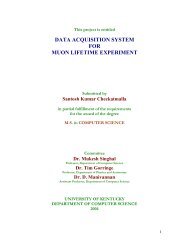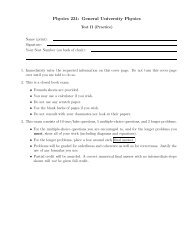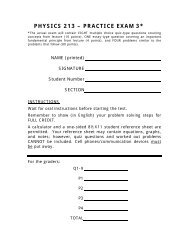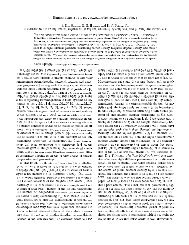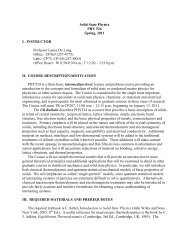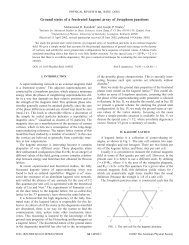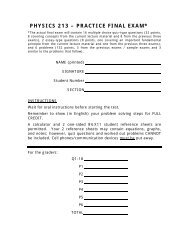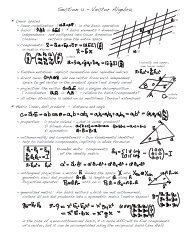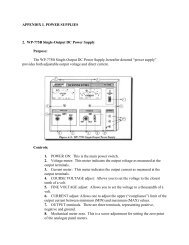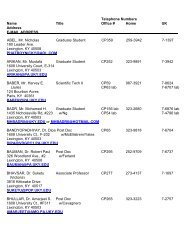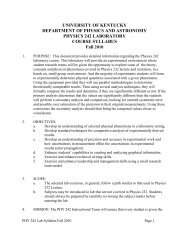Physics 500: Mathematical Methods (first midterm exam)
Physics 500: Mathematical Methods (first midterm exam)
Physics 500: Mathematical Methods (first midterm exam)
Create successful ePaper yourself
Turn your PDF publications into a flip-book with our unique Google optimized e-Paper software.
<strong>Physics</strong> <strong>500</strong>: <strong>Mathematical</strong> <strong>Methods</strong> (<strong>first</strong><br />
<strong>midterm</strong> <strong>exam</strong>)<br />
March 11, 2007<br />
Exam instructions This test is a three hour take-home <strong>exam</strong> which<br />
may be taken any time between now and Wed., March 14 2007 (the due date<br />
has been postponed because I have been tardy distributing the <strong>exam</strong>); the<br />
<strong>exam</strong> is due at the start of class on March 14.<br />
Though the time limit is nominally three hours, students may take an<br />
hour or so additional time, if absolutely needed. Note: the three hours need<br />
not be contiguous.<br />
If you have questions about the wording of problems on this <strong>exam</strong>, please<br />
send me email at djpriour@glue.umd.edu; I should be able to respond at least<br />
within 24 hours, though likely sooner.<br />
Materials permitted: The course text, <strong>Mathematical</strong> <strong>Methods</strong> for Physicists<br />
by Arfken and Weber is permitted, as are any notes handed out or taken<br />
during class. Worked homework problems may also be consulted. However,<br />
collaboration with classmates on this <strong>exam</strong> is strictly forbidden.<br />
1 Nonhomogeneous Second Order Differential<br />
Equations (25 points)<br />
• Consider the (homogeneous) ordinary differential equation<br />
my ′′ + ky = 0; (1)<br />
1
Show explicitly that the functions y 1 (t) = exp(iω 0 t) and y 2 (t) = exp(−iω 0 t)<br />
satisfy the differential equation given above and are linearly independent.<br />
(Hint:<br />
√<br />
let’s not forget about the Wronskian) Take ω 0 to be given<br />
by ω 0 ≡ k/m.<br />
• Now, let us <strong>exam</strong>ine the non-homogeneous equation<br />
my ′′ + ky = F cos(ωt), (2)<br />
where in general ω ≠ ω 0 . Exploiting the fact that we now have y 1 (t) and<br />
y 2 (t) (i.e. solutions to the homogeneous equation), obtain a function<br />
y p (t) which satisfies the non-homogeneous equation given above (note:<br />
a direct calculation is wanted; do not simply work backwards from the<br />
solution given in the next part of this problem).<br />
• Show by direct substitution into the non-homogeneous differential equation<br />
that a valid choice for y p (t) is<br />
y p (t) =<br />
F<br />
cos(ωt) (3)<br />
m(ω0 2 − ω 2 )<br />
2 Unitary Matrices and Eigenvalues and Eigenvectors<br />
(25 points)<br />
• As we begin this part of the <strong>exam</strong>, it is useful for us to keep in mind<br />
that for a matrix A (matrices will be shown here in bold-faced type),<br />
a vector ⃗v A is an eigenvector if we have<br />
where λ A is the eigenvalue of the eigenvector ⃗v A .<br />
A ⃗v A = λ A ⃗v A , (4)<br />
• In general, a Unitary matrix U is a complex-value matrix such that<br />
U † U = UU † = 1, (5)<br />
where 1 is the identity matrix and U † is the Hermitian adjoint of U,<br />
given by U † ij = U ∗ ji . 2
• We also recall that if all the entries of a unitary matrix U r are real,<br />
then the unitarity condition given above reduces to<br />
U r T is the matrix transpose of U r .<br />
U r T U r = U r U r T , where (6)<br />
• Consider the rotation matrix<br />
[ ]<br />
cos(θ) sin(θ)<br />
R =<br />
− sin(θ) cos(θ)<br />
(7)<br />
• With the inner product (dot product) for planar vectors given by ⃗v·⃗v ′ =<br />
(xx ′ + yy ′ ), show that the rotation matrix preserves the angle between<br />
two vectors; this amounts to showing explicitly that<br />
⃗v · ⃗v ′ = (R⃗v) · (R⃗v ′) (8)<br />
[ ] [ ]<br />
1 i<br />
• Show that ⃗v 1 = and ⃗v<br />
i 2 = are eigenvectors of R. What are<br />
1<br />
the corresponding eigenvalues?<br />
[ ]<br />
x<br />
• Show that an arbitary vector ⃗v = can be written in terms of the<br />
y<br />
eigenvectors as<br />
⃗v = 1 2 (x − iy)⃗v 1 + 1 2 (y − ix)⃗v 2 (9)<br />
Next, with ⃗v written in this manner, calculate R⃗v, exploiting the fact<br />
that ⃗v 1 and ⃗v 2 are eigenvectors of the rotation matrix R (you may leave<br />
the result in terms of ⃗v 1 and ⃗v 2 .<br />
• Now, again representing ⃗v as a linear combination of ⃗v 1 and ⃗v 2 , evaluate<br />
R 2 ⃗v. Based on the results for R⃗v and R 2 ⃗v, what expression would you<br />
anticipate for R n ⃗v? (Once again, it is fine to leave the result in terms<br />
of ⃗v 1 and ⃗v 2 at this stage.<br />
• Reexpress your result for R n ⃗v in terms of the components x and y of<br />
⃗v; show that the result is given by<br />
[ ]<br />
cos(nθ) sin(nθ)<br />
R n ⃗v =<br />
(10)<br />
− sin(nθ) cos(nθ)<br />
3
3 Constructing an orthogonal basis (25 points)<br />
• Consider a four dimensional Cartesian coordinate system with the general<br />
vector given by<br />
⃗v = (v x , v y , v z , v w ) (11)<br />
As a generalization to the three dimensional case, the inner product<br />
(i.e. the dot product) between vectors ⃗v a = (v ax , v ay , v az , v aw ) and ⃗v b =<br />
(v bx , v by , v bz , v bw ) is given by<br />
⃗v a · ⃗v b = (v ax v bx + v ay v by + v az v bz + v aw v bw ) (12)<br />
• Consider the three vectors<br />
⃗v 1 = (1, 1, 1, 1) (13)<br />
⃗v 2 = (1, 0, 1, 0)<br />
⃗v 3 = (1, 2, 3, 4)<br />
• Keeping in mind that two vectors ⃗v a and ⃗v b are orthogonal if v a ·v b = 0,<br />
use ⃗v 1 , ⃗v 2 , and ⃗v 3 to construct a set of three mutually orthogonal vectors<br />
(Hint: use the Gram-Schmidt orthogonalization procedure).<br />
4 Legendre polynomials and charge distributions<br />
with azimuthal symmetry (25 points)<br />
• Consider a linear filament of length L of uniform charge density λ;<br />
to exploit the azimuthal symmetry of this line segment charge, let us<br />
orient the filament so that it coincides with the z axis (i.e. as shown<br />
in figure 1) and runs from z = −L/2 to z = L/2; the total charge is<br />
Q = λL.<br />
• Our task will be to calculate the electrostatic potential V (r, θ) in terms<br />
of solutions to ∇ 2 V = 0 appropriate to our cylindrically symmetric<br />
situation, so we will seek an expression of the form<br />
∞∑<br />
∞∑<br />
V (r, θ) = (B l r l + A l r −(l+1) )P l (cosθ) = A l r −(l+1) P l (cosθ); (14)<br />
l=0<br />
l=0<br />
4
0<br />
z<br />
L/2<br />
λ<br />
−L/2<br />
P (x,0,z)<br />
y<br />
x<br />
Figure 1: choosing the coordinate system to exploit azimuthal symmetry;<br />
note that x = r sin θ and z = r cosθ.<br />
why do we immediately know that each of the coefficients B l vanish?<br />
• We calculate V (r, θ) via two avenues, and we will obtain the same result<br />
in both cases, a consequence of the uniqueness property of solutions to<br />
Sturm-Liouville equations. First let us deduce the expansion coefficients<br />
indirectly. Consider a point P = (0, 0, z) on the z axis directly<br />
above the charged filament; note that θ = 0 for this point.<br />
• For the point P, show by direct calculation that the electrostatic potentials<br />
is<br />
∫ ( )<br />
L/2 λdz ′<br />
z + L/2<br />
V (z, 0) = K = (KQ/L) ln<br />
(15)<br />
−L/2 z − z ′<br />
z − L/2<br />
= (KQ/L)[ln(1 + L/2z) − ln(1 − L/2z)]<br />
where it is assumed that z > z ′ and K ≡ 1/4πǫ 0 .<br />
5
• Now, keeping in mind that<br />
∞∑<br />
ln(1 + x) = x − x 2 /2 + · · · = (−1) i+1 x i /i, (16)<br />
i=1<br />
show that V (z, 0) can be expanded as<br />
∞∑<br />
V (z, 0) = 2KQ/L (1/i)(L/2z) i [(−1) i−1 − (1) i−1 ] (17)<br />
i=1<br />
∞∑<br />
= 2KQ/L (L/2) 2j+1 z −(2j+1) , (18)<br />
j=1<br />
so that we now have a power series in z.<br />
• Finally, determine the cofficients A l by equating the expansion formula<br />
V (r, θ) = ∑ ∞<br />
l=0 A l r −(l+1) P l (cosθ) at r = z and θ = 0 to the series in<br />
powers of z which you obtained earlier; show that<br />
V (r, θ) =<br />
∞∑<br />
j=0<br />
Hint: keep in mind that P l (1) = 1.<br />
KQ<br />
r (L/2r)2j P 2j (cosθ) (19)<br />
• Let’s carry out the same calculation, only in a more direct manner<br />
this time. The task now is to calculate V off of the z axis. We<br />
will lose no generality by concentrating on the point P = (x, 0, z) =<br />
(r sin θ, 0, r cosθ); show that the electrostatic potential at P is given by<br />
V (x, 0, z) = V (r, θ) = K<br />
∫ L/2<br />
−L/2<br />
λdz ′<br />
√x 2 + z 2 + (z ′ ) 2 − 2zz ′ ; (20)<br />
finally, show that this expression leads to a formula for V (r, θ) identical<br />
to that given in Equation 19. To work toward this goal, it will be useful<br />
to express x and z in terms of spherical polar coordinates as needed.<br />
Recall that the generating function for the legendre polynomials can<br />
be expanded as<br />
∞∑<br />
(1 − 2tx + t 2 ) −1/2 = t l P l (x). (21)<br />
You should obtain an integral of a series, and it may be helpful to<br />
note that you are free to exchange the order of the integration and the<br />
summation of the series; integrating term by term should lead to the<br />
desired result.<br />
l=0<br />
6



